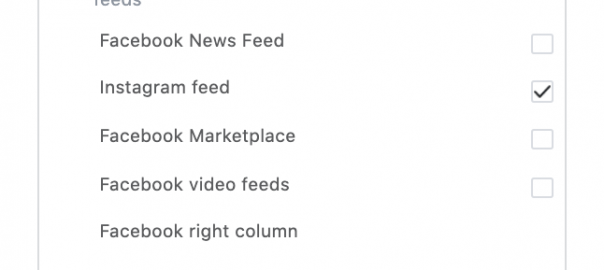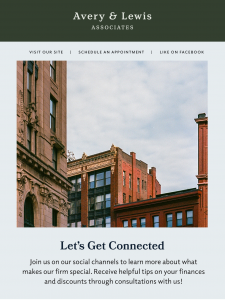The pros and cons of Instagram advertising, how much it costs, what ad formats are available and how to set up your first campaign.
Instagram has positioned itself as one of the fastest-growing social networks in recent years, passing the one billion monthly active user mark in 2018. The platform now enjoys stronger growth prospects than parent company Facebook and overshadows the likes of LinkedIn, Twitter, Snapchat and Pinterest in terms of user numbers.
More importantly, Instagram boasts the biggest engagement rates in the industry – and by a large margin too. In the age of visual social media, Instagram is the most “future-proof” of the established networks. Merkle data suggests advertisers are increasing Instagram spend at X4 the rate of Facebook.
In this guide, you’ll learn the strengths and weaknesses of Instagram advertising and how to create your first campaign.
Who should advertise on Instagram?
The most important factor in choosing which social networks to advertise on is their user bases. You have to go where your target audiences are and this means you need to understand the demographics of people using each network.
Facebook and YouTube are the only networks with enough users that you can say every possible target audience is within reach. Instagram isn’t all that far behind in terms of user numbers anymore but it does have some interesting characteristics to consider.
The pros and cons of Instagram advertising
Instagram pros:
- Fast-growing user base
- Excellent targeting options
- High engagement
- Connects you with Millennials and Gen Z
- A great visual branding tool
Instagram cons:
- Creating enough visual content can be demanding
- Minimal organic reach
Instagram users vs Facebook
According to Pew Research (visualisation by SproutSocial), the biggest difference between Instagram and Facebook is the age of their user bases. Much like Snapchat, Instagram is more popular with younger users during a time when the average age of Facebook users is increasing.
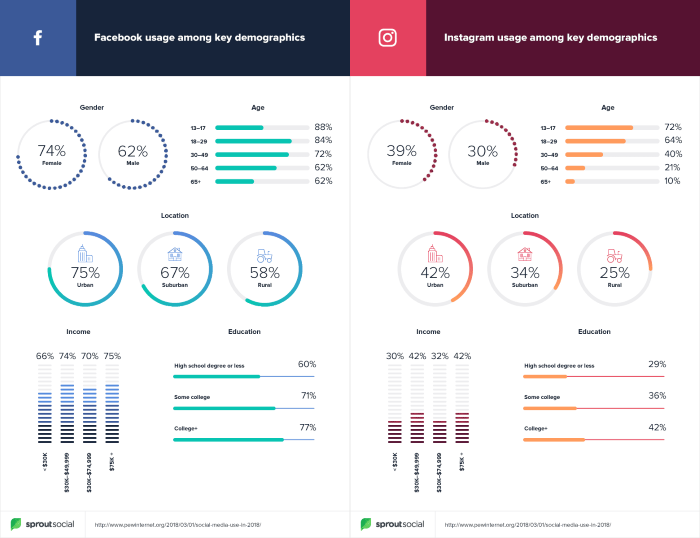
So, if you’re primarily interested in reaching Millennials and younger audiences, then Instagram instantly stands out.
Unsurprisingly, this also means the average income for Instagram users is lower than Facebook. This is compounded by the high-consumer nature of Instagram (fashion, cosmetics, food, travel etc).
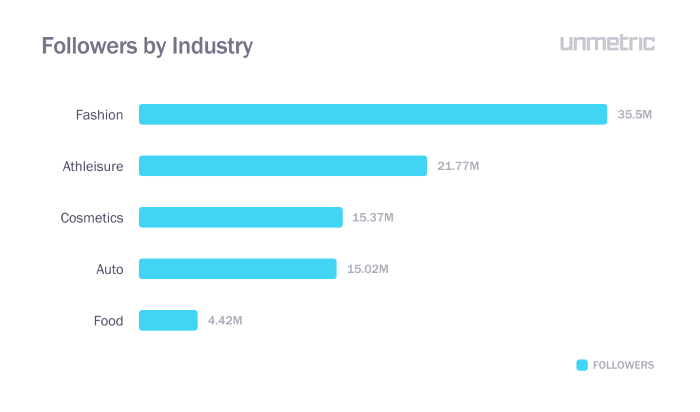
Source: Unmetric
As a result, Instagram shines as a B2C advertising platform for promoting products and services with strong visual appeal. This doesn’t mean the network can’t be used for B2B campaigns but it’s important to remember there are simply fewer business decision-makers on Instagram compared to LinkedIn, Facebook and Twitter.
They are there, just in smaller numbers.
Instagram is all about visually engaging content
Instagram is famed for being one of the most engaging social networks, meaning a higher percentage of users are likely to interact with your ads. Research from Rival IQ finds that Facebook generates an average engagement rate of 0.09% across all industries while Instagram tallies up an impressive 1.22%.
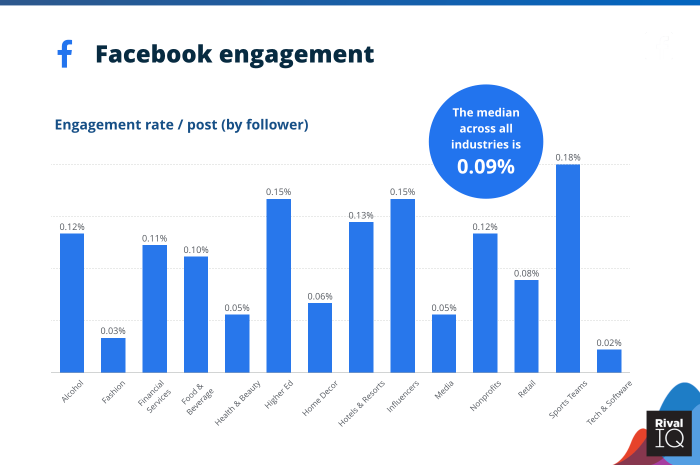
This is Instagram’s biggest selling point – while Instagram advertising is generally more expensive (more details in the next section), it boasts some of the best engagement stats in the industry.
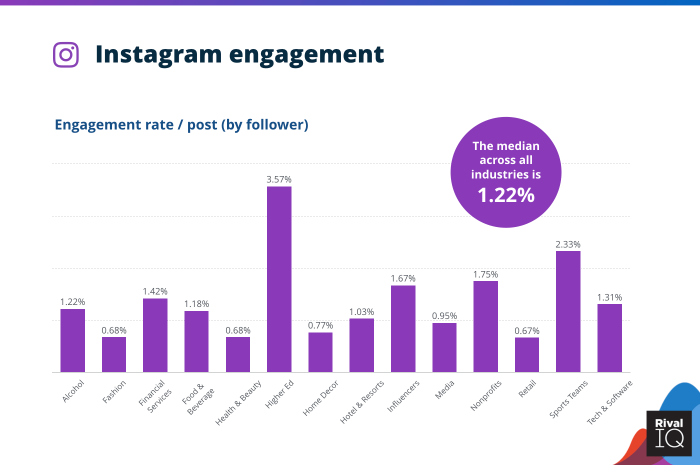
You have to work to achieve this kind of engagement on Instagram though. This is a visual network we’re talking about where images and videos dominate users’ feeds. So you need to be able to create visually striking ads that capture interest, stop them scrolling and encourage them to engage with your brand.
How much does Instagram advertising cost?
As mentioned in the previous section, Instagram ads are generally more expensive to run than Facebook. Twitter also offers more competitive CPCs these days and you can expect to pay slightly more than double on average for each click with Instagram advertising.
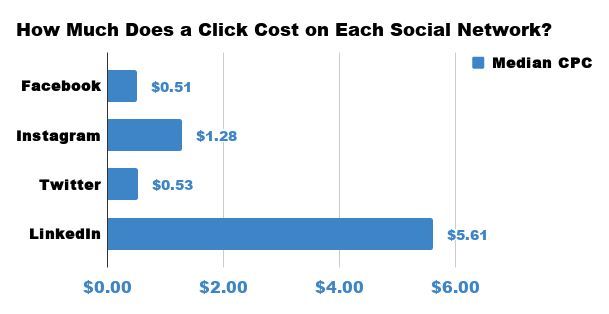
Your actual CPCs will vary from one campaign to another and also based on the industry you’re in. You could find yourself paying anywhere between £0.10 and £1.50 per click or roughly £5.00 per 1,000 impressions, depending on the bidding model you use.
So CPCs are definitely higher than Facebook but the average CPM (cost per 1,000 impressions) is often lower than equivalent Facebook campaigns – as found in research by Socialbakers.
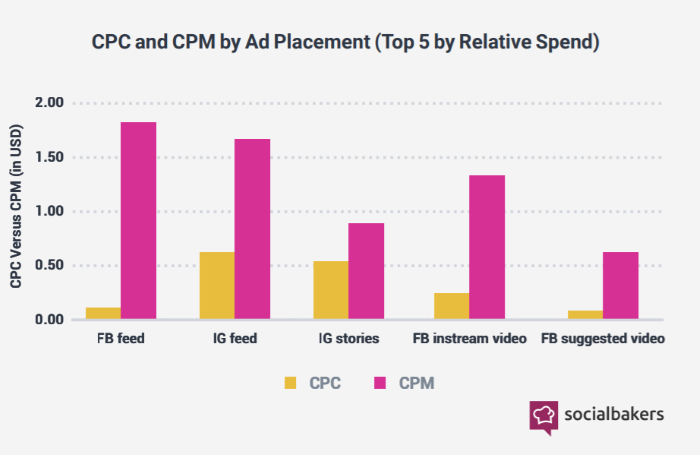
So you’re getting more impressions and significantly more engagement from Instagram ads but there’s a good chance you’ll be paying slightly more for clicks compared to Facebook. Which makes a strong case for using Instagram as a platform for building brand awareness, a wider audience and increasing engagement, even if you rely on other platforms more for generating traffic (at lower CPCs).
Instagram ad formats
Before we explain how to create your first Instagram advertising campaign, let’s take a moment to look at the ad formats available on the platform. There are five core ad formats you can choose from:
- Stories ads
- Photo ads
- Video ads
- Carousel ads
- Collection ads
All of these are visual ads formats which means you’ll need to create a series of high-quality images and/or video to get results from Instagram advertising. Now, let’s take a closer look at each of these ad formats and why you might want to use them.
Stories ads
Stories ads allow you to take over the entire screen with a series of images or a video clip. What started as a response to Snapchat’s innovative Stories feature has turned into one of Instagram’s most powerful ad formats cutting out all distractions and immersing users into your brand story.

Now, one-third of the most-watched Instagram Stories are from businesses and advertisers.
Photo ads
Photo ads are the most common type of ad you’ll see on Instagram. You have the option to include text and a call-to-action.
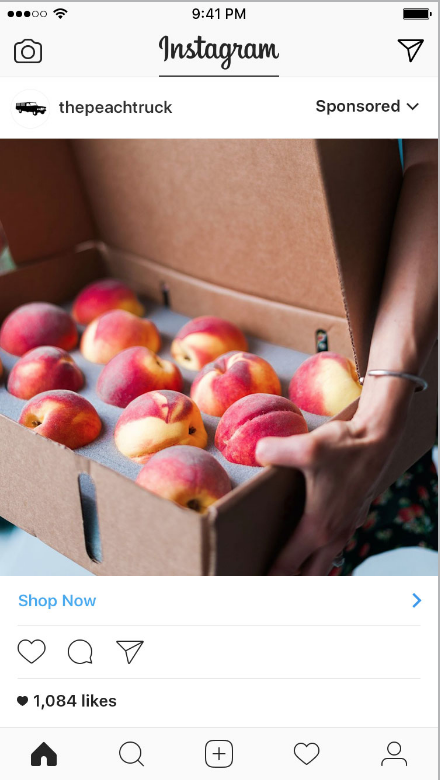
Video ads
Video ads create a space for you to capture attention with the power of motion. Your video ads can include footage of up to 60 seconds in length in either square or landscape format. Once again, you can include a small amount of text and a CTA to encourage clicks.
Carousel ads
Carousel ads allow you to place a series of images in a row for users to scroll through horizontally. These are ideal for showing a range of products that illustrate your brand offer – for example, a travel brand that wants to showcase a number of exotic locations in a single ad.

Collection ads
Collection ads are a more engaging ad format for showcasing multiple products. This ad type is designed to target purchase intent more than carousel ads, encouraging users to browse through a number of products within the ad itself and then click through to the retailer’s website to check out more items.
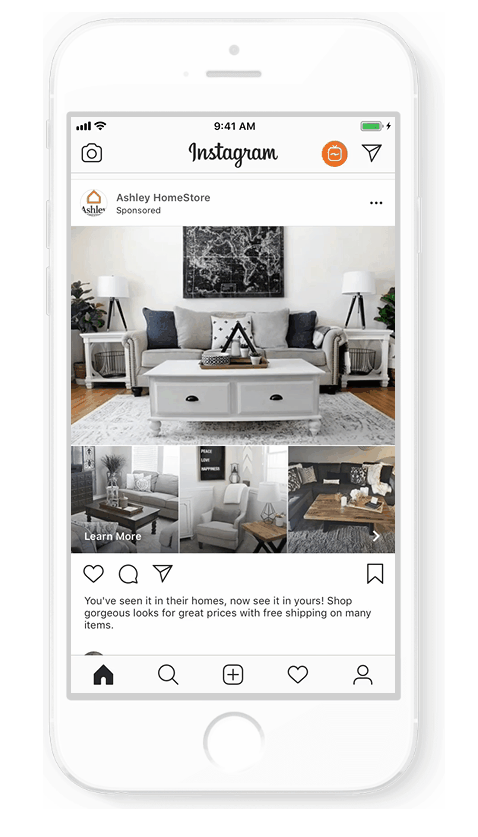
This is one of the most effective ad formats for generating eCommerce traffic from Instagram and ideal for targeting users that demonstrate a strong interest in buying from a brand like yours.
All of these ad formats can appear in users’ feeds and last year, Instagram also launched Ads in Explore, allowing users to see your ads when they’re looking for new content to engage with.
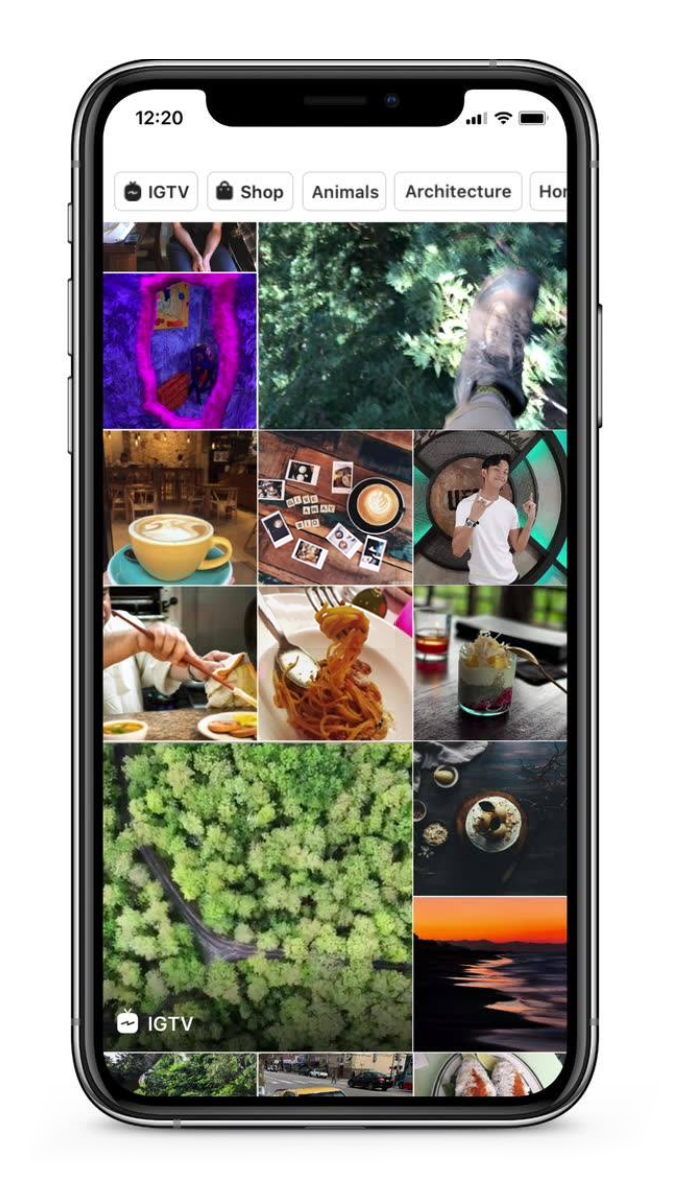
Instagram says that 50% of people on the network use Explore on a monthly basis to discover new content, which amounts to more than 200 million people every day. The network also says 83% of its users admit to finding new brands, products and services using the platform.
Setting up your first Instagram campaign
To advertise on Instagram, you’ll actually be creating and managing all of your campaigns in Facebook’s Ad Manager. If you’re already advertising on Facebook, creating your first Instagram campaign will be no problem at all.
1. Select your campaign goal
The first thing you need to do is choose your campaign goal. You’ve got eleven options to choose from here.
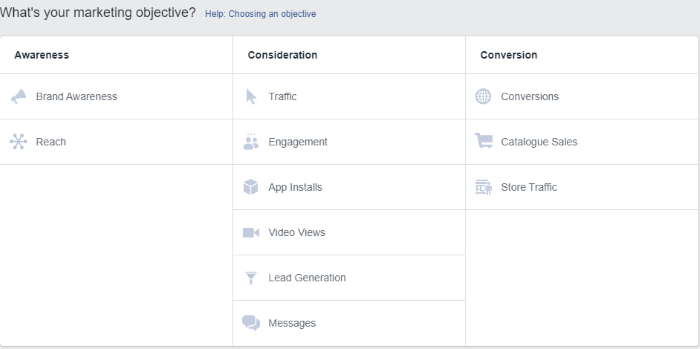
- Brand awareness: Increase overall awareness for your brand by showing ads to people who are more likely to pay attention to them.
- Reach: Show ads to the maximum number of people in your audience while staying within your budget. You can also choose to reach only people who are near your business locations.
- App installs: Drive more installs of your app by linking directly to the App Store and Google Play Store. You can also choose to target high-value users.
- Traffic: Grow the number of people who are visiting your site, app or Messenger conversation, and increase the likelihood that they’ll take a valuable action when they get there.
- Lead generation: Make it easy for interested people to learn more about your business. Encourage them to sign up for more info or spend time with your app or website.
- Messages: Prompt people to open more Messenger interactions. Scale your ability to have personal conversations with them – so you can answer questions, collect leads and boost sales.
- Engagement: Get more people to follow your Page or engage with your posts through comments, shares and likes. You can also choose to optimise for more event responses or offer claims.
- Video views: Show your videos to people who are most likely to be interested in them and watch them to completion.
- Conversion: Increase actions on your site or app. Whether you want purchases, leads, registrations or other types of conversions, this objective prompts people to do something.
- Store visits: Bridge the gap between people’s online and offline shopping journeys by driving store visits, sales and other valuable actions at your physical shop locations.
- Catalogue sales: Move more inventory by automatically promoting the most relevant products. Simply upload your catalogue and set up your campaign – and it will show the right products to the right buyers.
Depending on the objective you choose when you create a new campaign, Instagram will use this information to deliver your ads to the most relevant users – people who are most likely to complete the action you require.
2. Define your audience
Next, you’ll need to decide who you want to see your ads. Facebook has the most advanced targeting options in the industry and Instagram gets access to all of the same settings. Aside from targeting audiences based on their age and gender, you get advanced location targeting options and demographics setting for relationships, household makeup, work and more.
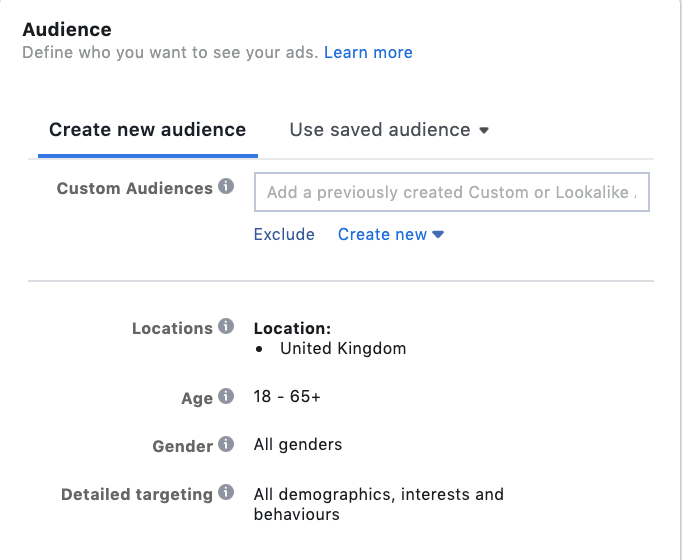
You also have the ability to deliver ads based on specific interests – for example, users who regularly engage with content related to mountain biking or golf.
Taking things further, you can use something called Life Events to target users based on key events in their lives, like graduating from university, getting engaged or having a child. You can even target Instagram users based on recent purchases they’ve made, which mobile operating system they use and how often they travel.
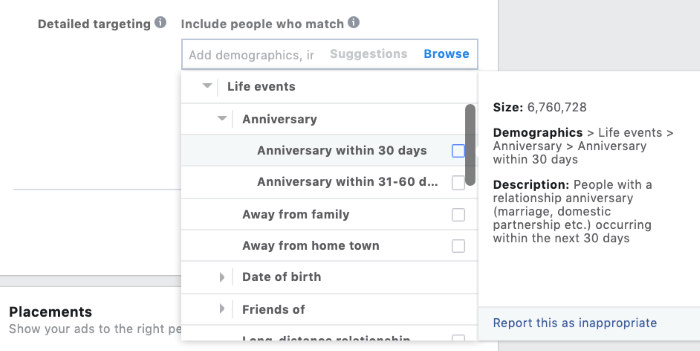
What makes these targeting options so powerful is the fact that you can layer them to pinpoint the most specific audiences imaginable and ensure your ads are seen by people with a demonstrable interest in your ads. No other advertising platform comes close in this regard.
There are far too many targeting options to cover here but we’ve got an in-depth guide to Facebook targeting that explains everything you need to know.
3. Choose where your ads will be shown
Once you’ve defined your audience, you’ll want to decide where your ads are going to appear. You’ve got four options here:
- Facebook: Your ads will show across Facebook ad spaces.
- Instagram: Your ads will show across Instagram ad spaces.
- Audience Network: Your ads will show outside of Facebook products on third-party partner apps and websites.
- Messenger: Your ads will show inside Facebook’s Messenger app.
All four of these placements are selected by default and you can choose which combination suits your campaign objectives. If your audience is quite broad, then it makes sense to run your ads across Instagram and Facebook but you might want to create separate campaigns for each network if you’re targeting very specific audiences.
As for Audience Network and Messenger, these are specialist placements and, ideally, you want to create ads designed for them specifically.
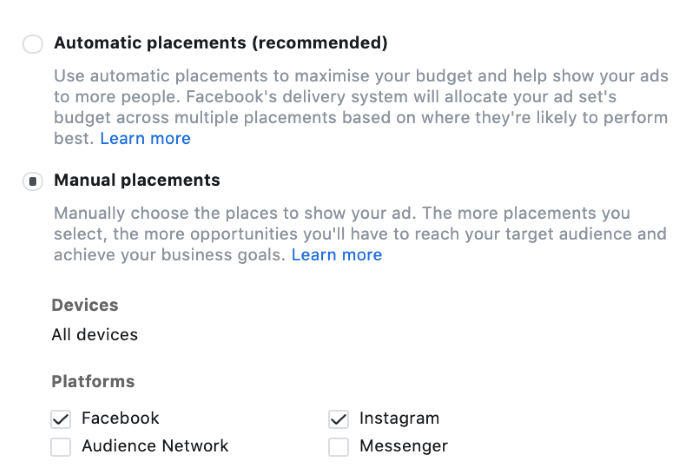
To select your placements, click on the Manual placements button and then select which combination you want to run with. As you can see, there’s also setting for Devices, which allows you to select All devices (default), Mobile or Desktop.
Once you’ve chosen your placements, you’ll be prompted to select which ad spaces you want your ads to be shown in. There are seven options here:
- Feeds: Facebook News feed, Instagram feed, Facebook video feeds, Facebook right column, Instagram Explore, Messenger inbox and Facebook groups feed.
- Stories: Facebook Stories, Instagram Stories and Messenger Stories.
- In-stream: Facebook in-stream videos.
- Search: Facebook search results.
- Messages: Messenger sponsored content.
- In-article: Facebook Instant articles.
- Apps and sites: Audience Network native, banner and interstitial, Audience Network rewarded videos and Audience Network in-stream videos.
The options available will be limited based on which of the four placement options you select and the format of your ad.
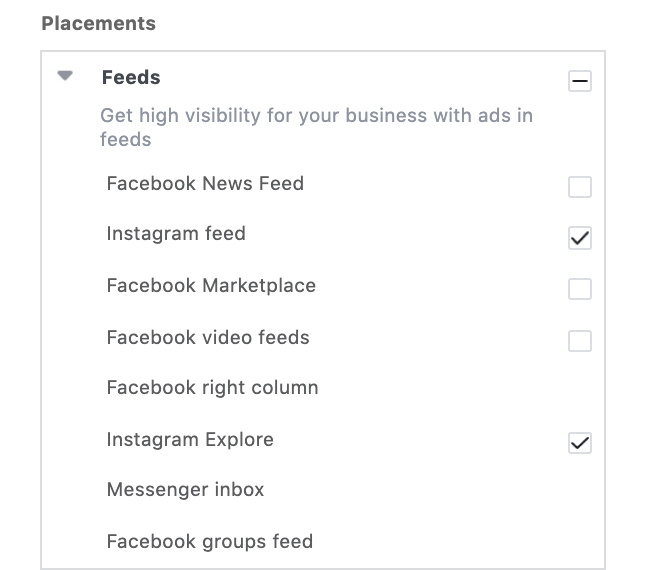
If you’re only looking to reach the widest possible audience (e.g. for a brand awareness campaign), you may even decide to simply select Automatic placements and let Facebook decide where your ads are going to be most effective.
4. Create your ad
Now it’s time to create your ad. The first thing you need to do is select which ad format you’re going to run with. The ad formats available at this point will depend on the campaign goal you selected earlier. For example, brand awareness campaigns only support two ad formats; Carousel and Single image or video ads.

Once you’ve chosen your ad format, Ad Manager guides you through the creation process. First, you’ll need to upload your media resources (images or video) and then define any text or links that you want included.
All the way, you’ll be given a preview of what your ad will look like. You can select specific placement previews to see how your ad will look different in the Instagram feed vs Facebook search results, for example.
5. Send your campaign live
Once you’re happy with your ad, you can check your campaign settings by hitting the Review button at the bottom right of the screen. Make sure everything is in order and change anything that doesn’t seem right. Then, you can hit the green Confirm button to send your campaign live.
Congratulations, your first Instagram campaign is now up and running!
Is Instagram advertising right for you in 2020?
Instagram has put itself in a really strong position over the past couple of years and it’s now one of the most reliable advertising platforms around. Its growth prospects are actually looking better than Facebook’s at this stage, which is especially true if you’re looking to engage with slightly younger audiences.
Instagram users are gradually getting older too, of course, but this network is a strong option if you want to target Millennials and younger generations. Facebook still has the advantage for B2B advertising – it’s clear that Instagram specialises in B2C marketing – but don’t rule it out as a place to reach entrepreneurs, digital professionals and freelancers.
Let’s also remember that today’s youngster’s are tomorrows CEOs and business-decision makers.
Instagram does have some challenges ahead though. The meteoric rise of Tik Tok, which already has more than 800 million users, means there’s genuine competition for younger users engaging with visual content. However, Tik Tok is far from producing an advertising platform that’s going to rival Instagram anytime soon.
Provided that you’re capable of creating the visual content required to make campaigns work on Instagram, this is one of the most compelling options available right now. In 2020, it’s still accurate to say pretty much every business wants to be advertising on Facebook and if you’re already doing this, you’re only going to benefit from advertising on Instagram, too – unless you’re targeting slightly older audiences, perhaps.
For a look at how Instagram stacks up against other social advertising platforms, take a look at our guide to social media marketing.
Digital & Social Articles on Business 2 Community
(110)
Report Post